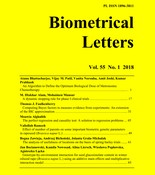
Biometrical Letters Vol. 55(1), 2018, pp. 17-30


This paper investigates a stopping rule to be utilised in phase I clinical trials. The motivation is to develop a dynamic rule so that a trial stops early if the maximum tolerated dose lies towards the beginning of a dose region. Also, it will employ many patients if the maximum tolerated dose lies towards the end of a dose region. A two-parameter logistic model is assumed for the dose-response data. A trial is stopped early before reaching the maximum number of patients when the width of the Bayesian posterior probability interval of the slope parameter meets a desired value. Instead of setting a pre-specified width to stop at, we determine it based on the parameter estimate obtained after a reasonable number of steps in a trial. Simulation studies of six plausible dose-response scenarios show that the proposed stopping rule is capable of limiting the number of patients to be recruited depending on the underlying scenario. Although the rule is applied to a D-optimum design here, it will be equally applicable to other model-based designs.

phase I clinical trial, maximum tolerated dose, sequential design, D-optimum design, early stopping rule

